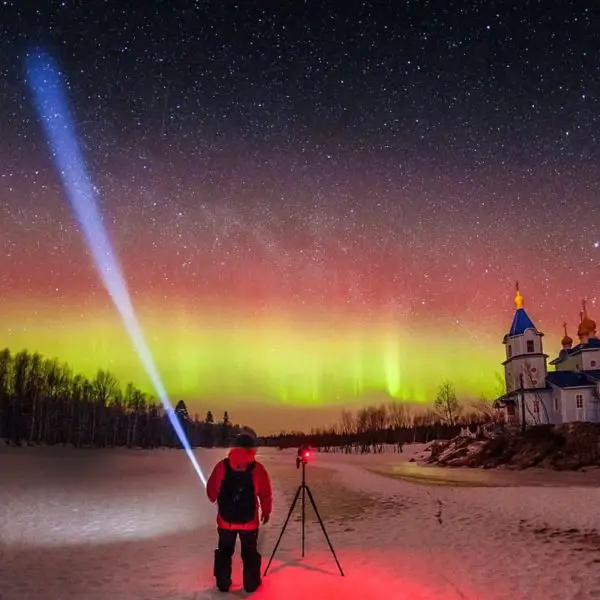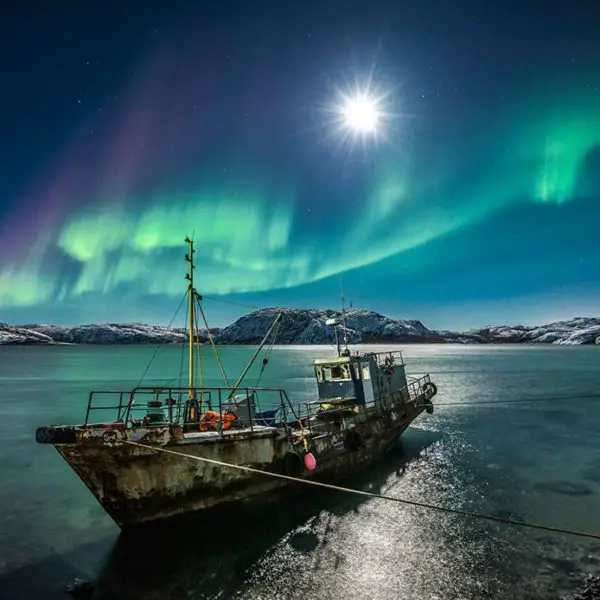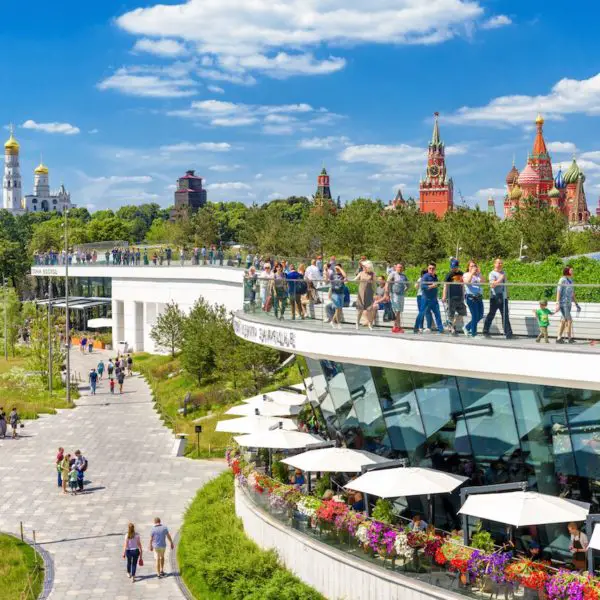Northern Lights in Russia - The Travel Guide
This guide was created to help travellers who are considering experiencing the Northern Lights in Russia. We look into some essential considerations that will help you plan for the best possible Northern lights experience and help you decide where how and to take it all in.
Table of Contents
What is the Aurora Borealis?
Standing beneath the ethereal glow of the Northern Lights as they perform their dazzling, shape-shifting solar dance is one of earth’s most spectacular atmospheric phenomena and a must experience on just about everyone’s bucket list.
The Northern Lights – origin myths and legends
Humans have been enthralled by the mysterious beauty of the Northern Lights for millennia. In northern Europe, the Aurora Borealis was believed to be light emanating from the celestial bodies of the gods as they guided the recently deceased into to the next world. Some Inuit tribes gazed up at the Northern Lights and imagined spirits playing an inter-stellar ball game with the skull of a walrus.
For many of us today, escaping the modern world to witness the awe-inspiring spectacle of the Northern Lights is a tremendously powerful and uplifting experience. While these days we have the science to explain exactly what causes Auroras to develop in the earth’s atmosphere, we’ll no doubt continue to look up at the Northern Lights with the same sense of inexplicable wonder held by our ancestors long ago.
How the Aurora Borealis is formed
Essentially, the Northern Lights are created when gaseous particles from the sun interact with the earth’s atmosphere and magnetic poles. This is why the Northern Lights are almost exclusively seen in the skies in areas close to earth’s north pole.
The colour of the Northern Lights depends on the particular atmospheric gas that combines with the rays emanating from the sun. If the reacting atmospheric gas is oxygen, the output colour is a pale yellowish-green. If the reacting gas is nitrogen, the Northern Lights appears blue or purplish-red. More rarely, the Northern Lights appear as a series of pulsating scarlet streaks. The red northern lights occur when the reacting gas is high altitude oxygen, usually around 200 miles above the earth’s surface.
At the opposite time of year, in the southern hemisphere’s winter, an almost mirror-like reflection of the Aurora Borealis, called Aurora Australis, regularly appears in the skies above the remote territories near the South Pole.
Experience Northern Lights in Russia or other countries?
Perhaps the biggest consideration when planning a trip to see the Northern Lights is which destination you’ll base yourself. So where should you think of heading?
Head for the Arctic Circle
Only eight countries in the world claim territory above the Arctic Circle, making them the only destinations to offer high chances of seeing the Northern Lights in season. Although the Aurora has been spotted at latitudes typical below the “Aurora Zone” (in Northern Scotland for example, such sightings are relatively rare.
The eight best countries for hunting the Northern Lights
The Northern Lights can be observed in the northernmost regions of Canada, large parts of Alaska and the northern regions of Iceland, Norway, Finland and Sweden, as well as southern Greenland. There are also several Aurora hotspots within the Arctic territories of Russia. Which destination you choose will, of course, depend on time and budget constraints and what sort of Northern Lights experience is best suited to your travel tastes.
Creature comfort touring vs true adventure travel
Northern Lights tourism is highly established in Scandinavia, and with the exception of some of the more isolated encampments in the region, is far more commercialised than other destinations in the Arctic, with better tourism infrastructure, more creature comforts, a wide variety of tour operators to choose from and plenty of accommodation all the way up to five-star luxury. Travellers may see the popularity of the Scandinavian destinations as something of a drawback. For one, you can expect bigger crowds and premium prices in a region with an already pricey reputation.
Go and see the Northern Lights just north of Reykjavik in Iceland for example, and you’ll usually find yourself sharing this long-awaited spiritual experience with dozens of other tourists, cars and coaches.
If your dream Northern Lights expedition means getting away from it all, communing with nature and absorbing a true sense of of the wild, lonely majesty of the Arctic, you might want to skip the more predictable places and consider some of the Arctic’s lesser-known hotspots and give a Northern Lights in Russia trip a go!
Why consider experiencing the Northern Lights in Russia?
The Scandinavian nations remain the “default destination” for many visitors embarking on annual Northern Lights expeditions. But did you know your chances of witnessing the glowing, ghostly spectre of the Aurora Borealis are equally as good in Russia? In fact, when it comes to far north excursions to see the Aurora Borealis in full flight, Russia might be the world’s best-kept secret.
Perfect conditions without the crowds
As Northern Lights tours have grown in popularity in recent years, the Russian Arctic has remained relatively under the radar, and this in itself offers a wonderful advantage. Peak season tourist crowds are virtually absent from even the best-known Aurora hotspots in Russia.
Tour groups are invariably small, and travel times are less taxing than you might expect. One doesn’t have to travel far from a major city, such as Murmansk (capital of the Kola Peninsula) to find themselves surrounded by endless expanses of pristine polar landscapes.
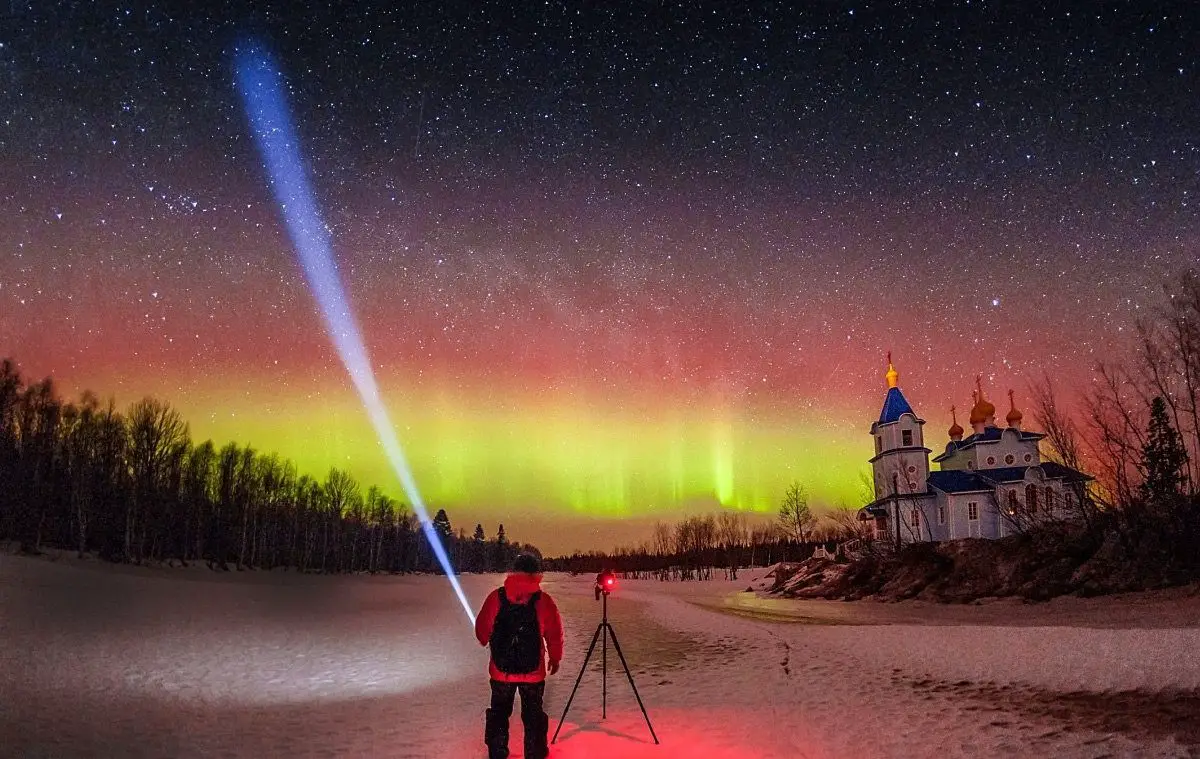
Imagine glittering white snow mounds in the tundra, jagged mountain peaks and the skeletal trees of the taiga, illuminated bright as day by the psychedelic hues of the Aurora. That, and almost complete solitude, is what a Russian Northern Lights expedition has to offer.
Not just uncrowded – cheap too!
Russia, of course, isn’t the only country that can provide an authentic, off the beaten track Arctic adventure. Remote parts Alaska, Canada and Greenland certainly fit the bill, but reaching these sparsely populated, infrastructure poor wilderness areas comes at a significant cost. Similarly, even the most bare-bones Northern Lights tours in Finland, Norway and Iceland couldn’t exactly be considered cheap. It’s a common belief among travellers that all Northern Lights tours are expensive. Yet it is possible to embark on an Aurora hunting adventure on a budget. Simply set your stargazing sights on Russia.
The best places to see the Northern Lights in Russia
Northern Lights tourism in Russia is becoming more and more popular over the past 5-10 years. there are few places in the Russian Arctic to have established a dedicated industry around the bucket list topping phenomenon.
Murmansk, Kola Peninsula
For the moment, Murmansk, the largest settlement in the Kola Peninsula, is Russia’s unofficial Northern Lights capital, and quite likely the world’s most affordable place to observe the phantom glow of the Aurora in Russia.
Located in Russia’s Kola Peninsula, the city lies 2° north of the Arctic Circle. With a population of over 300,000, it’s the largest city in the world above the Arctic Circle. It’s also most probably to be the cheapest place in the world to come and experience the Northern Lights either independently or on tour.
While it’s a surprisingly lively city, what makes Murmansk really unique it that it’s perhaps the only city where the Northern Lights forms its mesmerizing light show directly above the cranes, smokes stacks, factories and low-rise residential blocks of the town. Just beyond Murmansk lies a vast expanse of empty, mountainous tundra. Several vantage points just outside of town provide a panoramic view of the city as it becomes immersed in the alien green glow of the Aurora.
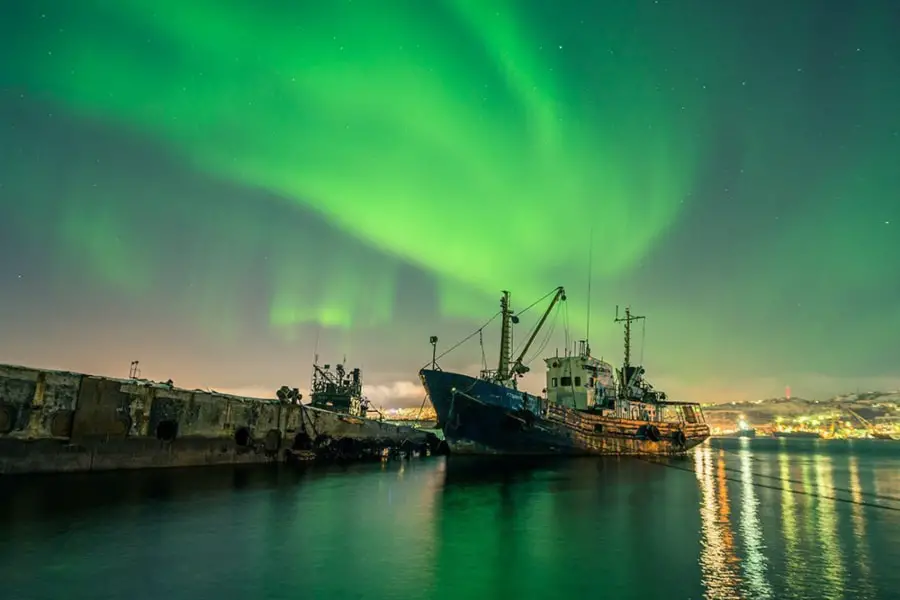
Russia, overall is a reasonably affordable country, particularly when compared to its neighbours in the Arctic Circle region. Domestic flights and overland travel (trains, buses etc.) are generally inexpensive, even though you’ll find yourself regularly having to cover massive distances. In winter, the 2.5 hour flight from Moscow to Murmansk might set you back around 8,000 RUB or $130 USD*.
As tourism is still in its infancy in the Arctic port city, Northern Lights tours in the Murmansk region are extremely modestly priced (relatively speaking), even covering snowmobile trips into the tundra in search of the lights, and extra activities such as dog-sledding and rural village visits.
While Murmansk makes a comfortable introduction to the Kola Peninsula, the best Northern Lights hunting happens within a good few hours drive from the artificial lights of the city. There are few settlements of any appreciable size in the Kola Peninsula. It’s a land dominated by a wild tangle of taiga forest and polar tundra with crystal clear lakes, grassland and rugged coastline in between.
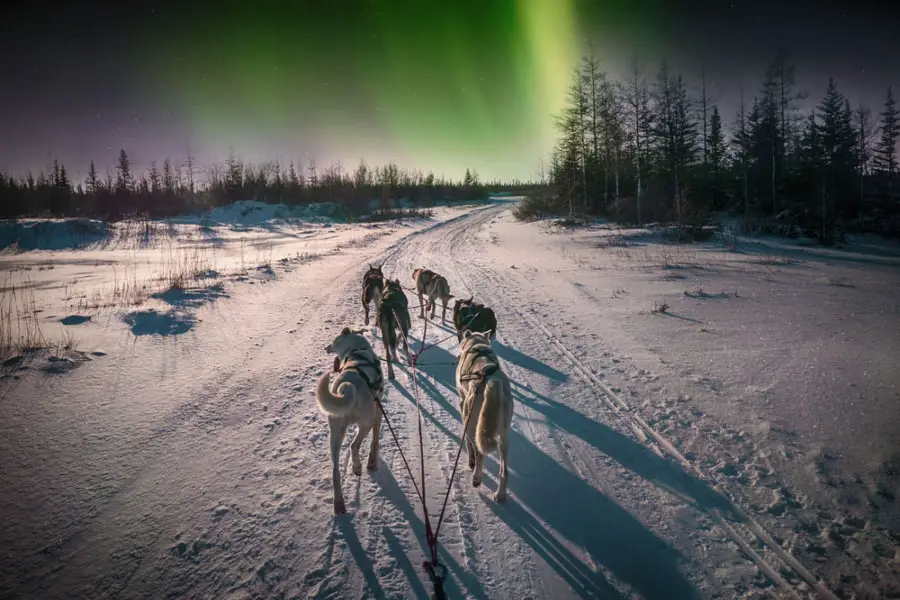
It’s out here in the unspoiled polar landscapes of the peninsula that the auspicious appearance of the Aurora can light up the land and sky in a full blaze of glory. The Kola Peninsula also has a rich and ancient cultural heritage to explore. The reindeer-herding Saami people, who are also indigenous to parts of Northern Scandinavia, still live in scattered settlements across the peninsula and have retained large parts of their traditional lifestyle.
Yamal
With a name that translates to “the edge of the world” in the native tongue, Yamal is the last refuge of the world’s nomadic reindeer herders, the Nenets.
Tours to the Yamal Peninsula generally have a strong focus on cultural immersion, involving homestays with Nenets families in their nomad camps and even participating in their grueling annual reindeer migrations. You can read more about the nomadic culture of Siberia’s Nenets here.
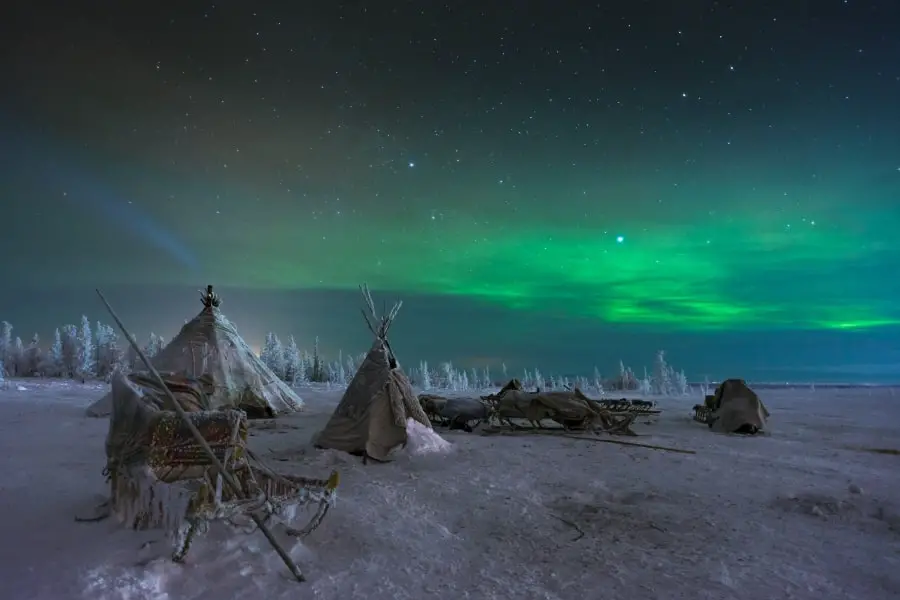
Over half of Yamal’s territory sits above the Arctic Circle. Outside of the twin towns of Salekhard (population 45,000) and Labytangi (population 25,000), the Yamal Peninsula consists of only a few isolated permanent settlements.
Around 50% of Yamal’s Nenets still engage in a nomadic way of life, following ancient north to south migratory routes twice a year, covering up to 1,000km each way. Hundreds of miles from civilization, the winter nomad camps of Yamal are among the most isolated, unspoiled destinations anywhere on earth to see the Aurora Borealis in all its celestial glory, shimmering above the starkly beautiful, star-strewn Arctic taiga.
On the odd occasion, the Northern Lights have been sighted far south as St Petersburg! This, however, is an extremely rare occurrence and the light pollution emanating from the city causes Aurora’s lights to appear dull and obscured. The further you are from the artificial glare of the cities, the more spectacular your sightings of the Borealis will be.
When to see the Northern Lights in Russia?
Which months of the year are best?
The appearance of the Northern Lights isn’t actually restricted to a particular season. The chemical reactions that form the Northern Lights are a constant occurrence, meaning the Aurora Borealis is actually hanging about in the sky all year round. But because the Borealis is only observed at high latitudes (between 65° and 72° North), it’s all but invisible from April through to August, when the aurora zone experiences extremely long periods of daylight. During this time, the sky never darkens enough to make the lights visible to the naked eye.
It takes the long hours of darkness and its pitch-black night skies to really showcase the Borealis’ blaze of electric glory at its best. The ideal time to see the Northern Lights varies somewhat depending on location, but as a general rule, the Aurora season starts at the end of August and finishes around mid-April. Peak season is usually considered to be between late September and March when temperatures are at their coolest and the Arctic regions experience very few hours of daylight. However, at slightly lower latitudes, it’s sometimes possible to catch superb views of the Northern Lights in considerably more comfortable August temperatures.
Polar Night
Polar nights are a natural phenomenon that occurs at latitudes to the north of the polar circle. In northwestern Russia, the circle passes through the southern part of the Kola Peninsula and part of Karelia. At Murmansk’s latitude, polar nights last about 40 days, while the phenomenon lasts half a year at the North Pole. The opposite phenomenon, polar days, occur during the summer when the sun does not set for the same period of time.
Even though the sun remains below the horizon, the Russian Arctic is not blacked out completely. On clear days, we can see beautiful sunset colours in the south while the sky to the north is a deep midnight blue.
Remember – the Aurora Borealis is unpredictable
What’s most important to keep in mind is that the Northern Lights, like any natural phenomenon, are unpredictable.
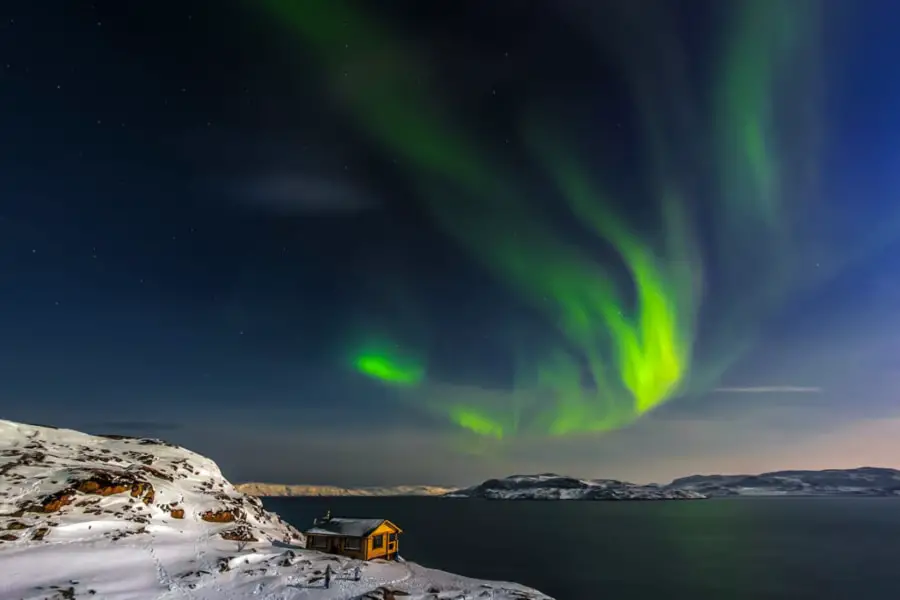
To get a picture-perfect view of the Lights requires pitch dark, crystal clear skies, free of any cloud cover. There also need to be solar flares and solar wind activity taking place in order to trigger the Aurora’s appearance. When the lights do appear, your time in their presence may be relatively fleeting (they can sometimes appear suddenly, only to vanish a few minutes later). On other nights, you could be treated to a 20 to 30-minute performance.
Thanks to technology, we now have Aurora forecasts online to predict the Aurora activity level in different regions. If you have your heart set on seeing the Northern Lights, you’ll want to maximise your chances by devoting several days at least to making dedicated Northern Lights expeditions far from the interference of light pollution from the cities.
Tips for a successful Northern Lights in Russia experience
Peak viewing season is best – just be prepared for the cold!
The truth is, you can get insanely lucky and see the Northern Lights outside the unofficial “Aurora Season”, but if you really have your heart set on seeing the lights at their best, we strongly advise visiting during Borealis prime time – winter!
If you do decide to visit in mid-winter, keep in mind that above the Arctic Circle, particularly in January and February, temperatures can drop to around -20°C. Because you’ll be spending a lot of time outdoors, it’s essential you pack or purchase appropriate clothing and prepare yourself adequately to face sub-freezing temperatures).
We recommend:
- Several underlayers – long-sleeve shirts and leggings (preferably made from a quick-drying material like polyester, nylon or merino
- A parka or insulated jacket to go over the top of your base layers. Jackets with a layer of duck down or synthetic insulation are especially good at holding in heat
- Snow and wind protection jacket – a quality ski jacket or windbreaker is a must when heading out into the tundra. A good jacket places a shield between you and the bone-chilling winds that often sweep across the Arctic
- Warm boots – unless your feet are warm and snug, the rest of your body is going to be cold! Ideally, you’ll want at least one pair of sturdy winter hiking shoes or snow boots, ideally with a waterproof or fleece lining. It’s also a good idea to buy one size up when it comes to winter boots, so you’ve got plenty of room to squeeze a pair of thick woollen socks inside.
- Gloves, winter hat or balaclava/face mask, hat and sunglasses – Believe us, you don’t want exposed fingers in -15°C weather. Particularly for photographers, ski gloves with removable layers are great for when you need a bit of extra dexterity. You’ll want a warm beanie as a bare minimum for keeping your head warm. An insulated winter hat with ear flaps is even better, and many have detachable full-face masks to prevent windchill drying the skin around your lips and nose.
Glare from the sun reflecting off the snow is less of an issue in winter, but it can still catch you off guard – it’s annoying and best and damaging to your eyes at worst, so bring a pair of polarised sunglasses along.
Spend as many days hunt as you can hunting for Northern lights in Russia
Like any natural phenomenon, the Northern Lights are subject to the unpredictable whims of nature. Sometimes you can show up on clearest, coldest night imaginable, but without sufficient solar flare activity, the Aurora will refuse to perform. To boost your chances of catching the elusive Aurora, you’ll want to devote at least several days to tracking flares of flashing light across the tundra. We recommend staying on the tour for 4-5 days to maximise your chances.
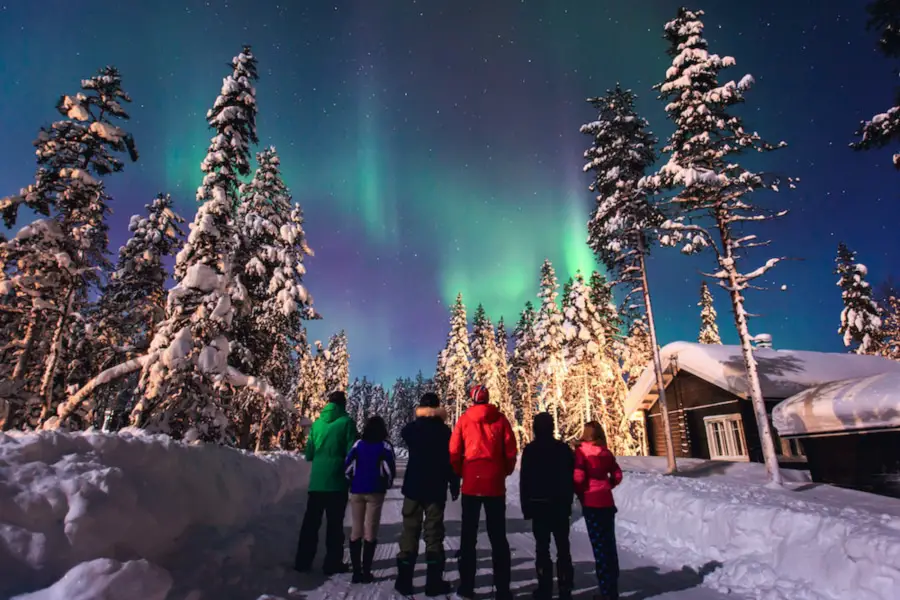
The Northern Lights most commonly appear between 5pm and 2am. On a Northern Lights tour, it’s usually only in the evening that the group will head out to hunt for the Borealis. During the day, you’ll be kept entertained with other snow activities while you wait for the darkest part of the night to fall, such as:
- dog-sledding
- snowmobiling
- ice fishing
- road trips to the remote areas
- skiing and more
Check the Aurora Forecast online
Or don’t. For some, experiencing the Aurora without the foresight of forecasts and predictions adds to its mythical, untamed appeal. Using current solar wind conditions, the US-based Space Weather Prediction Centre has created and mapped out an Aurora forecasting model online that predicts the location and intensity of the Northern and Southern Auroras.
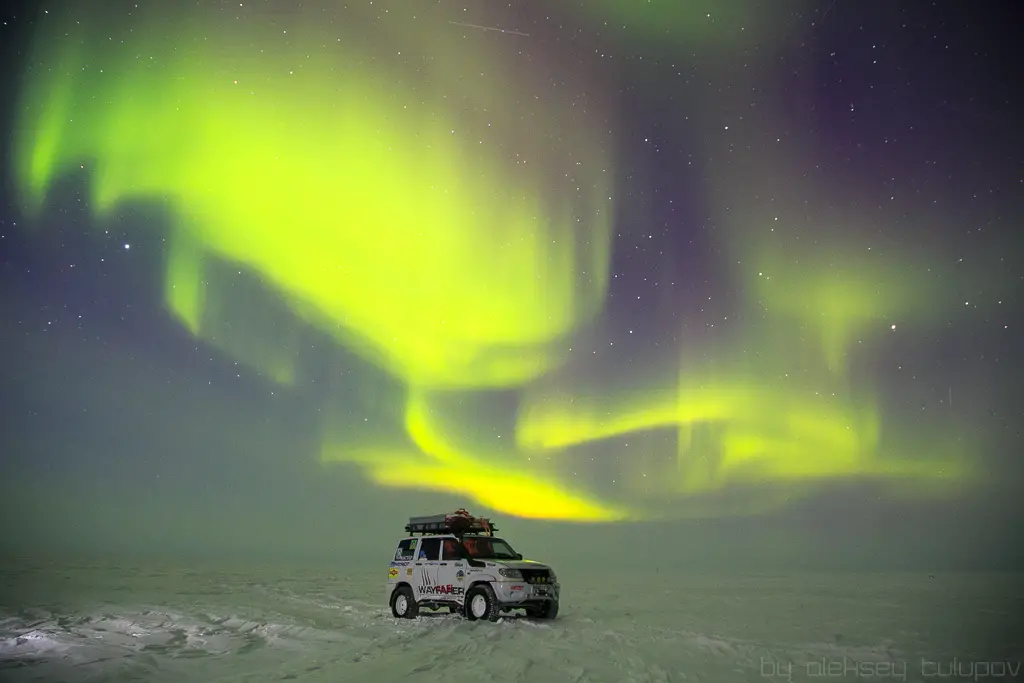
At the moment, the forecasts are only accurate to within about 30 minutes, however, they can hint at what the Aurora activity might be like a day or two either end. In fact, the SWPC has just developed a three-day Aurora forecasting system, which is available on their website as a trial.
Tips for photographers
In order to get stunning pictures of northern lights, you will need a tripod, a wide-angle lens, high ISO, manual focus (extreme values), a long shutter speed, a charged camera battery, patience and warm clothes. You must have a camera that can shoot at long exposures and that has an automatic shutter release function with the ability to set the time of the self-timer. The camera must be kept in a heat-insulated camera bag or under clothing. You will also need a tripod – it will be difficult to achieve the desired result without it, because the movement of the camera during shooting will cause the photographs to be blurred. Finally, be sure to take the following with you: a thermos, boots and a great desire, because not everyone will agree to freeze in the cold night, and the night sky and frost do not care that you came to see a true masterpiece.
When you arrive at the photo shooting location, look around, adjust the tripod, and try to set the optical exposure in advance, especially if, by chance, the city lights are going to get in the way. The shutter should be rather long, because the Northern lights are not very bright, but do not forget that the night-time should be seen in the photo. If possible, increase the sensitivity, but be careful – you don’t want the noises to mess up your efforts. Do not forget to set the time of the shutter button, for example, every 2 seconds.
As soon as you notice the flaming aurora, take your camera out, set it on a tripod, point it at an infinite distance, remove the lens cap (if any), then direct it towards the aurora and shoot with the adjusted settings. By the way, you should change the latter during shooting, because the aurora will probably make you adjust the exposure setting (close the aperture by a half or whole level, lower the sensitivity matrix or reduce exposure). Make sure that your hands are nowhere near the object-lens, otherwise they will fog up and the photo session will end because the moisture condensation will freeze immediately and you won’t be able to get rid of it until the object lenses become room temperature.
Ditch the camera once in a while and remember to take it all in
Everyone wants to come home with hundreds of mind-blowing photos and it’s hard to get any more show-off worthy than a perfectly timed image of the Northern Lights illuminating the glinting ice of the tundra. Whether you’re a total novice or a long-time pro, chances are when the lights do appear, they’ll be accompanied by the sound of camera shutters clicking every few seconds.
The first people in the Arctic looked up at the Northern Lights with extreme reverence, associating its mystical glow with gods, ghosts and spiritual realms beyond our own. Photographing the Lights is enjoyable, yet extremely demanding of one’s attention. It’s important to put the camera down once in a while and just enjoy the show. Your time is limited, so rather than endlessly fussing over camera settings, give yourself the chance to stop, take it all in experience the same sense of spiritual awe that has captivated humankind for countless generations.
Related posts
If you have any urgent questions or enquiries, please give us a call +61 412 587 785
